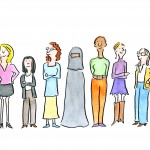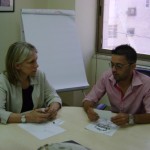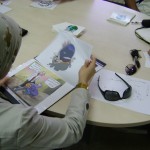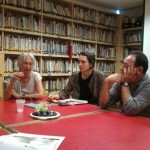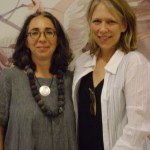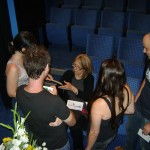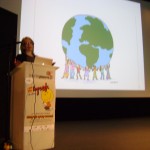Last week, I returned from a trip to the Middle East. I was invited by the US State Department to be a cultural envoy, and speak about my work to residents of Israel and the Palestinian Territories. Below is the talk I delivered in more formal settings, but I also met informally with cartoonists, artists and others to talk about freedom of expression, women’s rights, and the use of cartoons for the positive. I will write more later on my impressions in a future post.
Below are links to articles in Tel Aviv, Jerusalem and Palestinian Press:
Haaretz Globes WAFA Palestine News Agency Jerusalem Post Tazpit News Agency Huffington Post
“Everyone loves cartoons—we are drawn to them as if children. But some cartoons are often not for children. In many cases, cartoons can be attacks, they can be hurtful. they can cause death and destruction. Cartoons often use stereotypes as a tool to make a point, or get a laugh. And in this way they can be harmful. But they can be used to show our common humanity. Cartoons can be cultural envoys. Cartoons that are used to express opinions, but also cross boundaries, sometimes explain things, and be use for good.
I am a cartoonist for The New Yorker, a magazine that is known for its cartoons. What does The New Yorker have to do with the rest of the world– aren’t the cartoons in The New Yorker just about New York? I often get asked that. I have been drawing for The New Yorker all of my adult life (if you consider being 23 an adult, which is when I started), and I have a couple of answers to those questions. First of all, New York city is in many ways its own country. It’s its own world, and because there are so many immigrants, it is a melting pot. Over its 90 year history, the cartoons in the New Yorker have often represented many parts of NY culture. Yes, many of the cartoons in the New Yorker have been about its city. After all, the founder of the magazine, Harold Ross (who was not from NY), famously said that his magazine was not for the little old lady in Dubuque, Iowa. But the humor often crossed class boundaries. The cartoons in the New Yorker tend to be about the USA, but the best New Yorker cartoons, in my opinion, are the timeless ones. And, the ones that are about our common humanity.
That is why I consider many of the cartoons in the New Yorker to be political. Yes, there are the specific cartoons about political issues, elections, etc. The magazine has had political cartoons since its inception, and I have done many over the years. But then there are the political cartoons that are about how events affect individuals, not about specific leaders or wars or crisies. These are the type of political cartoons that I believe have the ability to communicate across borders. They are cartoons that express our shared humanity…even if we do not share the same language or cultures.
I consider all cartoonists to be linked somehow, if only by their passion for their art form. Most of us started when we were young, most of us felt like we didn’t fit in. We drew (and still draw) to try to understand our world, I think. And to make others laugh. It is our language. It is a language we all know, but one that can communicate with others.
When I was growing up, I was shy, and needed to find a way to express myself without talking. My mother gave me cartoon books, and I traced them, then developed my own style. I learned it was very rewarding to make people laugh, to make them happy—so I was addicted to drawing cartoons. Also, I was not a girly girl, so this was a way for me to feel I could fit in—as an artist who made people happy—without having to conform to the role of “woman.”
I did in fact become a woman, but I also became a cartoonist. I had always wanted to be a political cartoonist, and help save the world (I tended to dream big)—but as a young girl, did not feel I had opinions. I didn’t always like the cartoons that I saw in the New Yorker in the 1960’s, but I did see that there were political cartoons of a quieter sort – particularly the work of Nurit Karlin. An Israeli who had moved to NYC, Nurit’s work was captionless, quiet and sometimes political. I loved it. I thought, if her work could be in there, so perhaps could mine. Unbeknownst to me, she was the only woman cartoonist in the magazine at that time. So with my entrance, there were three women (the other one was Roz Chast who began shortly before I did).
The New Yorker had women cartoonists in it’s very first issue in 1925, but the numbers have always been low. The subject of women in the cartooning was not something I examined closely until 1998. I was invited to be on a panel of women political cartoonists at the Editorial Cartoonists Association convention. That experience, and the research I did in preparation, opened my eyes. Or perhaps I was simply ready to see and understand the reality.
Since then, the subject of women who are cartoonists continues to fascinate me. I wrote a few books about the subject, including a history of the women cartoonists at The New Yorker. I would like to share some of what I learned from my research, my observations and personal experience. One runs a risk when separating groups of people out of the general population, and I see this when I publish a book or curate an exhibit on women. But I believe that the risk of “ghettoizing women” is one worth taking if it gives us the opportunity to discuss women’s rights, freedom and why there are so few women in this field of cartooning. I believe that showcasing women’s ideas is good: it illustrates that we women are not all the same, and that we are talented and worth listening to.
The number of women professionally practicing the art of political cartooning is dismal. In the US, there are only two women drawing for newspapers, that I know of. At The New Yorker, the ratio is low as well: around eight women out of more than 50 cartoonists are women. When I began publishing cartoons in the late 1970’s, there were very few women making a living at this, let alone drawing cartoons. I was aware of the disparity, but as a twenty-year-old, it didn’t bother me because I knew what I wanted to do– I was benefiting from the feminist movement of the time. And I believed that what is important is quality. I thought: since most of us sign our last names, how do the editors know our gender? How can there be discrimination? This was a somewhat naive attitude. But actually, somewhat true, as well. The work has to be good, but there is discrimination.
Around the world, there are great restrictions on women, we all know the difficulties women face in different countries. Many cultures still treat women as property, rape is a tactic of war. Women’s ability to move in their cultures are restricted and they are often told what they can and can’t be, what they should and shouldn’t do. On a political and cultural level to differing degrees, this is true of every country around the world. And it’s true for creative freedom as well. The writer Virgina Woolf famously wrote a hundred years ago that women need income and a room of their own in order to be truly creative. What she was referring to was a freedom from the roles we are required to play, freedom to think how we want, create how we want. Obviously or a majority of the world’s women, this is not possible. The deck is stacked against women in so many ways, that it takes a great support system and tremendous will to break free and truly express oneself.
But things are changing. Around the world, many heads of state know now that in order to further the economic well-being of their countries, the dialogue must include the status of women. And while it might take a long time, it will continue to improve. Hillary Clinton famously challenged us in her speech at the United Nations conference on women in China in 2001, stating “Women’s rights are human rights, and human rights are women’s rights, once and for all.” The rights of women affect us all: culturally, economically, humanistically, creatively.
So where does this leave cartoonists? What is the role of cartoonists who are women? Are they different? How many are there? Of course I do not claim to know all the cartoonists who are women, but I have curated a number of exhibits with women from around the world and have met some of them. In a list generated by FECO, I counted fifty-one women out of hundreds of men. I believe that women have not become political cartoonists in the past for a number of reasons: lack of role models, lack of freedom politically, culturally (women are not supposed to be funny), and economically. And, most editors are male.
I believe that some cartoonists who are women offer a new perspective, one we perhaps have not heard before. Women do not all speak with one voice. In fact, we are all different and the feminist movement now speaks of the world as having “many femninisms,” that what is true for one woman in her culture is not necessarily true for another in her culture. I would like to show you some of the cartoons of the women I have met and been in touch with over the past several years.
There is no one truth—women around the globe have different perspectives. Our obvious commonality is the fact that we have the same bodies; plus, to one degree or another, women live very close to their cultures. We usually are the caregivers and teachers in most countries, we are the ones who intimately understand the rules of the culture. We have to know the rules, in order to navigate them for survival. Consequently, as cartoonists we may bring a new way of looking at global politics. In our art, we may provide a way that is not about rulers and wars and diplomats; rather an approach to issues that comes from the ground. An approach that comes from the people and families within a given community. Of course I am generalizing. Both men and women cartoonists do this type of cartoon, although not as often as we should. But I do believe that there is a way to approach world issues in cartoons that, because women are under-represented in this field, is waiting to be heard.
Cartoonists who are women have not had the opportunity or freedom in the past to draw cartoons, but there is hope. The field is changing rapidly, as newspapers disappear and the Internet takes over. This may provide a place for more women to publish their work, although sadly there is little money in it right now. Social media is allowing women’s art to be seen even from places like Iran and China. What we need to be sure of, so that the numbers of women entering this field continues to increase, is that the standards for what is considered “good” include different perspectives and approaches. This is where the Internet may be helpful for new voices. If we can continue to remove the physical and cultural barriers that women face in becoming cartoonists, then this—a rigid definition of what cartoon commentary is—is the final barrier that I see for women who are and who want to become, cartoonists.
We need to see and read cartoons from everyone around the world: all races, religions, genders. Many oppressed groups began using humor as a coping mechanism, and I know this to be true for women. Their humor, shared only within the confines of the group, was a way to deal with realities—but usually it was too risky to openly share with the majority. This dynamic is slowly changing, and what we can see through humor, particularly of the oppressed, can tell us much.
So much in the world is so painful, and cartoonists can speak about this so poignantly.
Because they often reach us on a non-verbal level, cartoons can be quick, insightful and very powerful. Humor –sometime with a message of hope—can help us see our shared humanity and understand one another. All of us cry and feel the pain of world events. But we all laugh, too.”
Some of the people I met from Israel and the Palestinian Territories:


